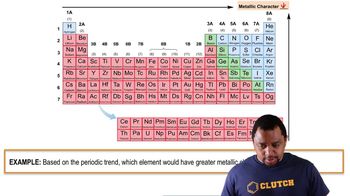Here are the essential concepts you must grasp in order to answer the question correctly.
Ionic Character
Ionic character refers to the degree to which a bond between two atoms exhibits ionic properties, as opposed to covalent properties. It is determined by the difference in electronegativity between the two atoms involved in the bond. A higher electronegativity difference typically indicates a greater ionic character, leading to a bond that is more polar and has distinct positive and negative charges.
Recommended video:
Metallic Character Example
Electronegativity
Electronegativity is a measure of an atom's ability to attract and hold onto electrons in a chemical bond. The Pauling scale is commonly used to quantify electronegativity values, with fluorine being the most electronegative element. Understanding the electronegativity of bromine and fluorine is essential for estimating the ionic character of the BrF bond, as their values will indicate how the electrons are distributed in the bond.
Recommended video:
Percent Ionic Character Calculation
The percent ionic character of a bond can be estimated using the formula: % Ionic Character = (1 - e^(-0.25 * (ΔEN)^2)) * 100, where ΔEN is the difference in electronegativity between the two atoms. This calculation provides a quantitative measure of how ionic the bond is, allowing for a clearer understanding of the bond's nature and its properties in various chemical contexts.
Recommended video:

 Verified step by step guidance
Verified step by step guidance


